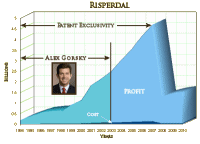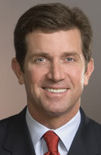We are the stuffed men
Leaning together
Headpiece filled with straw. Alas!…
 Eliot’s Hollow Men expressing his disillusionment with the Europe between the World Wars seems to me a fitting description for the period we’re in with matters psychopharmacologic and psychiatric right now. We’ve been through a prolonged period in which there has been a massive change within psychiatry, with a preoccupation on brain science and a concomitant explosion in the place of psychopharmacology in the treatment of mental illness. looking back on it, that explosion hinged on two groups of drugs – the SSRIs and the Atypical Antipsychotics which pored onto the market in a cascade of competing individual drugs. Those years are still fresh enough to remember all the energy, but far enough behind us to look pretty empty and hollow. Risperdal® was a central player, the first of the new Atypicals that arrived on the market in 1994 soon followed by fierce competitors. Almost from the get-go, J&J was aiming for the beyond
Eliot’s Hollow Men expressing his disillusionment with the Europe between the World Wars seems to me a fitting description for the period we’re in with matters psychopharmacologic and psychiatric right now. We’ve been through a prolonged period in which there has been a massive change within psychiatry, with a preoccupation on brain science and a concomitant explosion in the place of psychopharmacology in the treatment of mental illness. looking back on it, that explosion hinged on two groups of drugs – the SSRIs and the Atypical Antipsychotics which pored onto the market in a cascade of competing individual drugs. Those years are still fresh enough to remember all the energy, but far enough behind us to look pretty empty and hollow. Risperdal® was a central player, the first of the new Atypicals that arrived on the market in 1994 soon followed by fierce competitors. Almost from the get-go, J&J was aiming for the beyond  Schizophrenia off-label market when it was launched and shepherded by now J&J CEO Alex Gorsky. In the TMAP Trial, sales rep Tone Jones described it this way, "You can’t be a billion dollar drug in a 1% market" [cognitive dissonance…] You can’t get much clearer than that. At the end they were raking in over $4 B/year using any and every means to milk every market. Who were the Hollow Men? A better question is who wasn’t. Ed has the documents:
Schizophrenia off-label market when it was launched and shepherded by now J&J CEO Alex Gorsky. In the TMAP Trial, sales rep Tone Jones described it this way, "You can’t be a billion dollar drug in a 1% market" [cognitive dissonance…] You can’t get much clearer than that. At the end they were raking in over $4 B/year using any and every means to milk every market. Who were the Hollow Men? A better question is who wasn’t. Ed has the documents:Pharmalotby Ed Silverman11/04/2013…The criminal fines and forfeiture total $485 million, while the civil settlement with the federal and state governments amounts to $1.72 billion [here is the criminal information, the plea agreement, one civil settlement and another civil settlement, and a link to all of the exhibits]…
…The agreement, however, does not include lawsuits brought by three states where J&J has appealed judgments over Risperdal marketing. For instance, J&J was ordered by a South Carolina judge to pay $327 million for deceptive marketing, which he called detestable [look here]. And in Louisiana, a jury ordered J&J to pay $257.7 million in damages for making misleading safety claims, and $73 million in legal fees were later added. In Arkansas, J&J is waiting a date to argue before the state Supreme Court…
I know this isn’t the last suit. Several others are on appeal. But this is the big one. By my extrapolation, they made $34 B on this drug. That dwarfs the magnitude of this settlement. But beyond the usual "cost of business" commentary, what does it say about the era it was such a part of? J&J closes out the escrow fund set aside for this settlement. Alex Gorsky goes to his West Point Anniversaries and Boy Scout Board meetings an ongoing success story [shoveling…]. And what was this all about?
Don’t forget what they are STILL making on Invega, just a knock off of Risperdal.
What it means is that there are still a lot of people on Risperdal, and the $$$ from refills keeps on coming in.
That these suits are being won is a good sign, and I expect that with the ACA, insurance companies prescribing medicines without evidence-based guidelines will fade out, especially when there’s evidence that the costs of the medications are too high in price and effects. Now that the profits of insurance companies are limited, there is a lot of incentive for them not to pay for over- medication.
Should RA1SE produce good outcomes, insurers would be more inclined to pay for well rounded treatments to lower their overall costs. Given the likelihood that patients put on many medications would become debilitated and require medication for life (with companies that can’t drop coverage), or paying a little more up front to help a person stabilize and return to or stay at a job, it would be wise to gamble on the second, given that it has shown to be statistically more successful and less costly than heavy-handed drugging indefinitely.
Haven’t posted here in a while, and curious to mention my mom in two separate posts, but I am convinced that Risperidal contributed to my mother’s death when we moved her into a nursing home in the last weeks of her life. The use of Risperidal in geriatic populations is, IMHO, a savage departure from the most basic standards of care and human decency.
I went over her meds again and again with the staff at the facility: No neuroleptics except for Seroquel at night, which we only used when her hallucinations became unbearable, and we knew was well tolerated in tiny doses.
But I would show up in the evening, notice an abrupt decline in her functioning, and ask the nurse, “Was she given Risperidal again?” because I knew she’s had a terrible reaction to it. Always, the answer was an automatic “no.” I would go to the nurse’s station, pull her chart myself as they protested and threatened to call security, and there it was, again and again. Happened like four times.